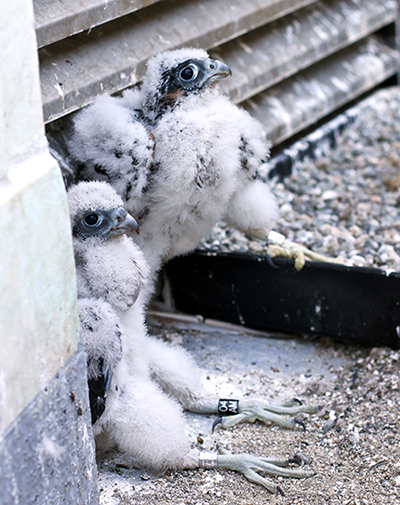With Campanile’s peregrine chicks ready to fly, volunteers ready to help
The two young birds are at risk of crash landings as they take their first flight off the 307-foot bell tower, expected between July 2 and July 9
June 26, 2017
This Fourth of July, fireworks might not be Berkeley’s only skyline attraction. Two peregrine falcon chicks — the first to be born on UC Berkeley’s Campanile — are expected to take their first flight off the 307-foot bell tower between July 2 and July 9. Peregrine chicks usually fledge 38 to 42 days after they hatch.

Peregrine falcon fledgling on the Brooklyn Bridge in New York. This is close to what the Campanile’s fledglings will look like when they first start flying. (Photo of the Peregrine falcon by David Schenfeld via Flickr)
Mary Malec, a volunteer raptor nest monitor for the East Bay Regional Park District, says “fledglings fly well, but land badly.” For peregrine chicks, flying is natural, she says, but they need experience to learn how to land. Malec is organizing a group of volunteers to be on “fledgewatch” throughout the week the chicks are likely to start flying.
Berkeley News spoke to Malec about fledging and what campus onlookers can do if they come across a fledgling on the ground.
Berkeley News: What happens when peregrine chicks fledge?
Mary Malec: They usually fly out into the wind — toward the west in this case — then turn around and try to fly back, but it’s hard to gain height. They may try to land against the side of the Campanile. They will hang on like a moth (we call it “mothing”), then they will drop off and fly again. By then, however, they will be tired and will lose more altitude. That’s when they seem to end up on the ground. I expect they might make it to the carillon level. That would be fine if no one is there — they can sit on the ledge or on the bells and rest. If people are there, they could be flushed off before they are ready.
What are other reasons they might end up on the ground?
There are a lot of ravens and crows around campus. Ravens and crows mob fledgling raptors and can force them to the ground. The adults will defend them but the fledglings cannot defend themselves at that point. The adults will fly out with the fledglings and will follow them and try to guide them.
What time are they likely to fledge?
Fledging can happen at any time of the day but most seem to go off fairly early in the morning. We hate when they go off at dusk — it makes life hard.
Can you tell us more about the group of volunteers who will be on “fledgewatch”?
Eight people have volunteered so far. We will cover from early morning to dark. As for shifts, people’s time will vary from a couple of hours to all day, depending on what time they have on any particular day. We will probably add more.
The core group of volunteers includes people who have been working together for about 11 years in San Francisco, Fruitvale and other places to do fledgewatch. The worst place in the world for fledging peregrines is the nest on the 33rd floor of the PG&E building in San Francisco. We’ve had to stand in front of buses to stop grounded fledglings from getting run over. We’ve had to rescue them from inside of buildings. We’ve lost some almost every year because they crash into the glass walls of downtown buildings.
We will also have two Berkeley graduate students, who are both raptor banders with Golden Gate Raptor Observatory; someone who works on campus, who is also a bander; the director of Golden Gate Raptor Observatory; and a couple of people who have never done this before.

The two female peregrine chicks on the Campanile after they were banded on June 19. (Photo by Mary Malec)
What should people do if they see a peregrine chick on the ground?
We will be hanging flyers around campus. The flyer says, “Peregrines are nesting on campus. I am a baby peregrine and I need to be off the ground. If you see me on the ground, I am in danger and need immediate help. Please don’t try to pick me up. Call Mary Malec at (510) 332-7513, Doug Bell at (510) 520-3945 or animal control at (510) 981-6600.”
If I’m not on campus, I live in North Oakland and can get there quickly. Or I can call whoever on the fledgwatch team is there. I will be contacting both animal control and Lindsay Wildlife Experience to let them know about the fledglings. We’ve worked on many occasions with Lindsay to get fledglings back to their nesting area once they are cleared to go — the last time was two weeks ago with a grounded peregrine at the Fruitvale Bridge.
Is Berkeley’s campus a good place for chicks to fledge?
The campus offers them many safe choices other than returning to the Campanile to land. There are buildings all around with good, safe roofs to land on and they will instinctively land as high off the ground as they can. They do not need to go back to the Campanile. The adults will bring them food wherever they are, except the ground. The newly fledged birds will “hunger scream” and the adults will hear them and find them. In fact, even if we have lost sight of them, the adults will find them. If we watch the adults, we can find the fledglings.
Is fledgewatch easier when the chicks are the same gender?
We are a bit lucky this time in that both fledglings are females. When we have males and females, it extends the fledgewatch time period by many days. Males fledge at about 40 days old, females at 42-43 days old. It takes them a couple of days after fledging to learn to land well enough to stay safe. Both of the chicks on the Campanile are about the same size and the same age, so I think they will fledge within hours of each other. We will continue to watch for several days after they fledge to make sure they are doing well.

A peregrine falcon adult and fledgling do an aerial food exchange at Morro Rock in California. (Photo of the Peregrine falcons by Teddy Llovet via Flickr)
How long will the chicks stay on campus after they fledge?
The fledglings will stay around for several weeks after they start to fly, maybe as long as a couple of months. At first, the adults will bring food to them. Then they will bring food to them in the air and the fledglings will take prey from the adults by turning upside down under the adult and taking the prey from the adult’s talons. Then they will start to catch their own food in the air. Then they will fly off on their own. The adults are likely to stay around all year and nest again next year.
Read more on Berkeley News about the Campanile’s first peregrine family in a Q&A with Doug Bell, a wildlife manager with the East Bay Regional Park District, and in an update by Mary Malec with photos of the two chicks being banded.